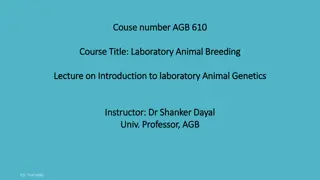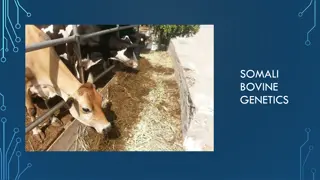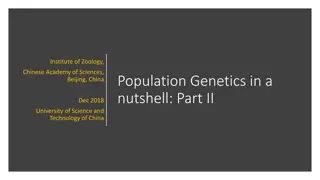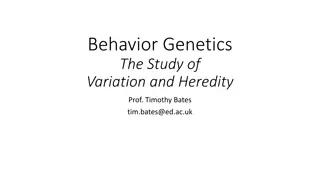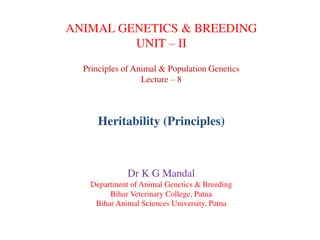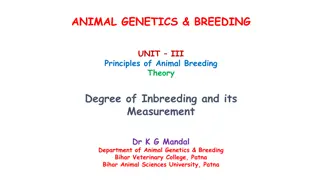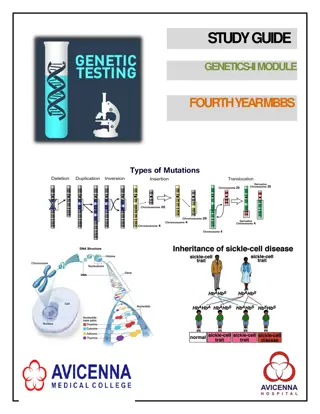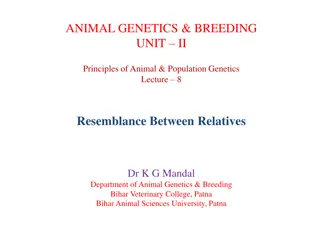Understanding Animal Genetics: A Comprehensive Overview
Animal genetics is the study of heredity, inheritance of traits from parents to offspring, genetic material like DNA, chromosomes, genes, alleles, and nucleotides. It involves the understanding of chromosomes in different livestock species, DNA as the carrier of genetic information, genes as units of heredity, alleles as gene forms, nucleotides as DNA building blocks, and nucleic acids' role in genetic information storage and protein synthesis. Discover the significance of nitrogenous bases and phosphate groups in nucleic acids, essential components for DNA and RNA.
Download Presentation

Please find below an Image/Link to download the presentation.
The content on the website is provided AS IS for your information and personal use only. It may not be sold, licensed, or shared on other websites without obtaining consent from the author. Download presentation by click this link. If you encounter any issues during the download, it is possible that the publisher has removed the file from their server.
E N D
Presentation Transcript
Genetics The study of heredity or how traits are passed from parents to offspring
Chromosome Rod shaped structure in the nucleus of a cell consisting of genes Occur in pairs except in the reproductive cells
Pairs of Chromosomes in Livestock Livestock Species Turkeys Chickens Horses Cattle Goats Sheep Swine Humans Pairs of Chromosomes 41 39 32 30 30 27 19 23
DNA Deoxyribonucleic acid A nucleic acid containing the genetic information for all living cells
Gene A segment of DNA, occupying a specific place on a chromosome, that is the basic unit of heredity
Allele One of two or more forms of a gene
Nucleotide The basic building block of DNA and RNA Made up of nitrogenous base, a sugar, and a phosphate group
Nucleic Acids The main function is to store and transmit genetic information and use that information to direct the synthesis of new protein. Two types exist- DNA & RNA RNA has 3 types with different functions mRNA carries information from nucleus to cytoplasm tRNA carries amino acids rRNA forms ribosomes
Three Types of Nucleic Acids A Nitrogenous base A Phosphate group A 5-carbon sugar
Nitrogenous Bases 5 main bases divided into two categories Purines Adenine Guanine Pyrimidine's Thymine Cytosine Uracil
Phosphate Group Same among all nucleotides
5-carbon sugar Comes in two forms Deoxyribose as found in DNA Ribose as found in RNA
Purines vs. Pyrimidine's Purines are double-ringed Pyrimidine's are smaller and only single ringed.
Proteins Large molecules made of amino acids that are essential to the structure and functioning of all living cells
Codon A sequence of three nucleotides that specifies amino acid addition during protein synthesis
Trait Characteristics passed from parents to offspring
Dominant An allele which masks the expression of another allele at the same locus Represented by a capital letter
Recessive An allele that is masked by a dominant allele and only causes a detectable characteristic in an organism that has two copies of that allele Represented by a lower case letter
Dominant and Recessive Traits in Livestock Dominant Polled cattle Black Holstein or Angus Belted pattern in swine Trotting gait Black Horse Recessive Horned cattle Red Holstein or Angus Non-Belted Pattern-swine Pacing Gait Chestnut horse
Heterozygous A condition in which two different alleles code for the same trait One dominant AND one recessive
Homozygous A condition in which two alleles for a given gene are the same Both dominant OR both recessive
Genotype and Phenotype Genotype Amount, order, and type of genes an individual has Genetic make-up of an individual (i.e. heterozygous or homozygous) Phenotype Physical traits an individual expresses
Gamete A reproductive cell sperm and egg
Breeding Generations P Generation - parental generation F1 Generation - filial Generation 1stoffspring of P generation F2Generation - 2ndFilial Generation Offspring of F1Generation
Gregor Mendel An Austrian scientist and monk who demonstrated that the inheritance of certain traits in pea plants follows particular patterns Known as the father of modern genetics
Mendels Experiment P Generation Allowed different varieties of plants (ex. purple or white flowers) to self pollinate for several generations All offspring displayed only one form of a particular trait (purebred) Crossbred the two strains of the P generation Resulted in all purple flowers
Self-pollination of F1Generation Results in F2Generation 1 out of every 4 flowers was white
Mendels Laws Law of Segregation Law of Independent Assortment
Law of Segregation Every individual possesses a pair of alleles for any particular trait Each parent passes a randomly selected copy (allele) of only one of these to its offspring When any individual produces gametes, the copies of a gene separate so that each gamete receives only one copy (allele)
Law of Independent Assortment Separate genes for separate traits are passed independently of one another from parents to offspring Different traits are inherited independently of each other Only true for genes that are not linked
Law of Independent Assortment
Biologist have discovered that Mendels laws are simplifications of processes that are sometimes much more complex However, they form a important foundation for the science of genetics!
Heritability The capacity of a trait to be passed down from a parent to offspring May lead to genetic improvement of animals Natural: survival of the fittest - adaptation Artificial: animals with desirable traits are selected for breeding programs
Highly Heritable Livestock Traits Carcass traits Ribeye area Backfat thickness Percentage of muscle Scrotal circumference Marbling score Tenderness score
Low Heritability Livestock Traits Number of offspring (hogs and sheep) Weaning weight Conception rate Calving interval
Heritability Rates Estimated Percent Heritability Trait Cattle Sheep Swine Fertility 0 - 10 0 - 15 0 - 15 Weight of young at weaning 15 - 30 15 - 20 15 - 20 Postweaning rate of gain Fat Thickness over loin Loin-eye Area 50 55 50 - 60 25 - 30 40 - 50 -------- 40 - 50 50 - 70 -------- 45 - 50 Percent lean cuts 40 - 50 -------- 30 - 40 Agriscience Fundamentals & Applications
Environmental Influence Most traits are a combination of selection and environment External environment includes temperature, light, altitude, humidity, disease, and feed supply Feed supply is the most important environmental factor
Environmental Influence Contd Environmental impact may influence the degree to which genetic improvement can be made through selection An animal must have a suitable environment to reach its genetic potential Larger environmental influence of production traits results in lower genetic improvement due to selection
X and Y Chromosomes Determines sex of animal Females= XX *bird eggs=XY Males=XY b *bird species sperm=XX Males may contribute either an X OR Y chromosome determining the sex of offspring
Sex Determination Male Gametes X Y X XX XY Gametes Female X XX XY
Sex-linked Traits Traits determined by an allele located on a sex chromosome Most are located on the X chromosome Longer and carries more genes Called x linked trait Maternally inherited from carrier mothers (a person who carries an allele without exhibiting its effects, such an allele is usually recessive) or from infected fathers
Sex-linked Traits More common in males due to their heterozygous (XY) state If they receive an X chromosome with the trait they will express that trait. Females express the recessive condition only if she inherits two recessive alleles
Sex-linked Traits in Animals Calico fur color in domestic cats Orange/black color gene is carried on the X chromosome Orange is dominant to black, but when present in conjunction with the recessive black allele a patchwork of orange and black appear




